Halides: Fluorite
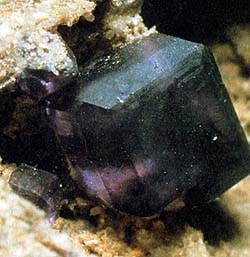 Diagnostic card.
Diagnostic card.
The samples demonstrate the fine crystallization of the mineral (in the photo: fluorite is a mineral of violet color).
Ca F 2
Cubic amount of cubic zirconia
Hardness 4
Specific weight 3,1-3,2
Cleavage is perfect
Crack irregular
Colorless colorless
Color in powder white
Glitter glass

Fluorite - fluorspar - calcium fluoride. Glitter is glass. Transparent, except for intensely colored varieties. Colors: purple, blue, blue, black, yellow, green, pink; Less often colorless. The line is white. Fracture stepped, smooth to shell. It's fragile. Cleavage, very perfect in octahedron, fluoresces. It is formed in igneous and sedimentary rocks, as well as under hydrothermal conditions. Well-formed crystals of cubic syngony are rare. They are often presented by cubes, octahedra or their combinations. Often there are dense granular or pentagonal aggregates. A common mineral of hydrothermal veins and metasomatic deposits, crystallizes in voids of veins and pegmatites. One of the main metallurgical fluxes, facilitating the smelting of metals from ores.
 Fluorite is represented by cubic and octahedral crystals, sometimes of large size. Per octahedron, perfect cleavage is observed. Doubles with mutual germination of crystals are not rare. Dense masses, earthy and concretionary formations are often observed. Color is variable: pure fluorite is colorless and transparent, but the mineral is yellow, red, green, blue, almost black. The color of the dash, however, is always white. The gloss of fluorite is glass, it is easily scratched by the blade of a knife; By weight it is rather heavy. Fluoresces in the ultraviolet rays with violet-pink light.
Fluorite is represented by cubic and octahedral crystals, sometimes of large size. Per octahedron, perfect cleavage is observed. Doubles with mutual germination of crystals are not rare. Dense masses, earthy and concretionary formations are often observed. Color is variable: pure fluorite is colorless and transparent, but the mineral is yellow, red, green, blue, almost black. The color of the dash, however, is always white. The gloss of fluorite is glass, it is easily scratched by the blade of a knife; By weight it is rather heavy. Fluoresces in the ultraviolet rays with violet-pink light.
Chemical composition - content (in%): Ca - 51.2; F, 38.8; Impurities of chlorine, iron, rare earths, sometimes uranium, etc. are noted. Hexaoctahedral symmetry. Cleavage is perfect by (111). It occurs in the form of well-formed cubic, rarely octahedral and rhombododecahedral crystals 3-5 cm in size, sometimes up to 20 cm and even more. Of the other simple forms, the faces (012), (013), (113), (112), (123) Etc. The faces of the cube are usually smooth, and the octahedra are matte. Twins of fluorescence germination are common, they are common in the sixth order aggregates, as well as solid granular, powdery or earthy (ratovkit) masses
Diagnostic signs.
Like all minerals containing calcium, the color of the gas flame has a characteristic red-orange flickering tonality. The hardness, cleavage and appearance of crystals fluorite easily differs from other minerals of calcium (calcite, gypsum, anhydrite). Has a strong glass up to a dim luster.
Origin.
Fluorite is of hydrothermal origin. It is formed in veins, mainly with sulfides of lead, zinc and silver. Pegmatite genesis may be less common. As an accessory mineral is present in the voids of igneous rocks. Can also have a sedimentary origin, depositing from the water in enclosed pools.
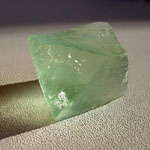


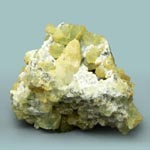
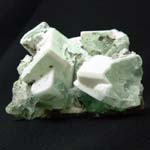
Place of Birth.
The best crystals are found in English deposits (Uyerdale near Durham, Alston Moore and Clitoris Moore in Cumberland). These are cubes of green or violet color, in association with calcite, barite, quartz, sphalerite, galena and siderite. In Canada, excellent specimens are found in the vicinity of Thunder Bay, mostly in association with amethyst. Other deposits in North America are located in Ontario and Illinois, where the largest industrial developments are located. In Europe, in addition to British deposits, worthy of attention are specimens from Saxony, having a special tan color. The Swiss fluorites, the so-called alpino, extracted mainly in the Gotthard zone, are unique in their red color and characteristic octahedral appearance. In Italy, interesting samples of fluorite, amazing in their transparency and colorlessness, are present in Corvara, Alto Adige, and in Sarrabus, in Sardinia. Sparinate fluorite is widely distributed in the veins of Santa Barbara near Collio and Val-Gunn, province of Varese, where it is accompanied by galena. Magnificent violet crystals are abundantly found in the Commissionon near Zogno (Val Brembana). Small, but rather elegant purple crystals are found in the granite cave in Baveno. Pink octahedral crystals of the "alpino" type, similar to the Swiss fluorites from Gottard, can be found in the gneisses in the gneisses of Beaur and Villadosola (Verbania).
Application.
Fluorite is the most important mineral raw material for the production of hydrofluoric (hydrofluoric) acid. It is also indispensable in the production of ceramics and plastics, in the optical industry; The most transparent crystals are used for making lenses and prisms in spectrography. Finally, fluorite is used in the remelting of bauxite and as a flux in metallurgy. Species. Among the varieties of fluorite is worth mentioning anthozonite, dark blue-violet, almost black color, which is characterized by a strong smell of free fluorine and ozone, as well as chlorophane, green.
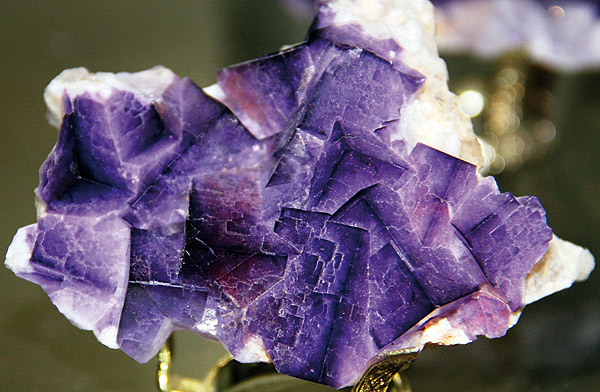
Fluorite. Morocco (north-western part of Africa). Deposits of minerals. Photo: © А.А. Evseev
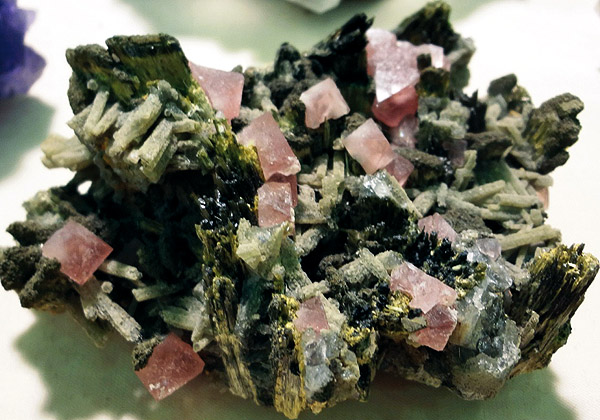
Fluorite (pink), quartz, hedenbergite, Inside. Mongolia, China. More than 10 cm. Photo: © А.А. Evseev
In the human body, fluorine stimulates immune defense and hematopoiesis, increases the resistance of teeth to caries, participates in the growth of the skeleton, prevents osteoporosis. The fluorine content in the human body is 2.6 g. Fluoride when injected into the body is absorbed very quickly in the intestine (similarly to chlorides). In the body, fluorine is in a bound state, in the form of sparingly soluble salts with calcium (fluorite), magnesium, iron.
Fluorine in the body stimulates the hematopoietic system and immunity, stimulates reparative processes in bone fractures, and also prevents the development of senile osteoporosis. Signs of fluoride deficiency: dental caries, osteoporosis. Food sources of fluoride: a large amount of fluoride is contained in fish (in mackerel, cod and soma - up to 5-10 μg / g), lamb, veal, in the liver, nuts (walnut). A lot of fluoride is contained in eggs, milk, spinach. Fluoride is rich in fluoride, the content of fluoride in it is 75-100 mg% (when brewing, 2/3 of the total amount goes into the solution). Drinking water contains 1 mg of fluoride per liter.
The absorption of fluoride in the gastrointestinal tract depends on the solubility of their salts and the concentration of calcium (forms fluorite). Fluoride inhibits iodine metabolism and can induce goiter. Magnesium inhibits the absorption of fluoride by the body. Some authors give evidence that fluorine also inhibits acid-forming bacteria. Fluoride for humans is an extremely important microelement, as it is vital for normal growth and development.
Manifestations of excess fluorine: the appearance of chalk-like spots on the teeth ("false teeth", "teeth of the shark"), destruction of tooth enamel, fragility of teeth, osteosclerosis (fluorosis) osteomalacia, osteoporosis, calcification of tendons and ligaments, formation of bone spurs; Hemorrhages in the gum area, mucous membranes of the mouth and nose, loss of voice, dry suffocating cough; Bradycardia, lowering blood pressure; Itching, irritation and peeling of the epidermis, disorders of fat and carbohydrate metabolism. Fluoride increases the risk of osteosarcoma.
ADR 2.1


Highly flammable gases
Risk of fire. Risk of explosion. Can be under pressure. Risk of suffocation. May cause burns and / or frostbite. Capacities can explode when heated (over-dangerous - almost do not burn)
Use shelter. Avoid low areas of the surface (pits, lowlands, trenches)
Red diamond, ADR number, black or white flame
ADR 2.3

Toxic gases . Skull and crossbones
Danger of poisoning. Can be under pressure. May cause burns and / or frostbite. Capacities can explode when heated (highly dangerous - instantaneous gas spreading around the neighborhood)
Use the mask for emergency leaving the vehicle. Use shelter. Avoid low areas of the surface (pits, lowlands, trenches)
White diamond, ADR number, black skull and crossbones
ADR 3


Highly flammable liquids
Risk of fire. Risk of explosion. Capacities can explode when heated (highly dangerous - easily burned)
Use shelter. Avoid low areas of the surface (pits, lowlands, trenches)
Red diamond, ADR number, black or white flame
ADR 6.1

Toxic substances (poison)
Risk of poisoning by inhalation, in contact with skin or if swallowed. Dangerous to aquatic environment or sewer system
Use a mask for emergency leaving the vehicle
White diamond, ADR number, black skull and crossbones
| The name of a cargo that is particularly dangerous for transportation | room
UN |
Class
ADR |
| FLUORINE | 1045 | 2 |
| FLUORANILINES | 2941 | 6.1. |
| Fluorobenzene | 2387 | 3 |
| Fluorodichloromethane see DICHLORFLUOROMETHANE (GAS REFRIGERANT R 21) | 1029 | 2 |
| FLUOROSILICATE, NZK | 2856 | 6.1. |
| FLUOROTOLUOLS | 2388 | 3 |
- Ghetchellit - "New Almaden blend" - arsenide and antimony sulfide (modern sulfosol)
- Antimony is a toxic metal (semimetal) , widely used in metallurgy, medicine and engineering
- Zirconium - a rare and undiscovered metal and the most dangerous precious stone in oxide and salt
- Gold - yellow dangerous and poisonous metal of modern accurate digital and cable technologies
- Sulfur is a golden-yellow toxic substance and a sign of active volcanic activity
- Cadmium is an undisputed toxic silvery metal unknown to a wide range of people
- Lead - a toxic gray imitator of metallic silver and toxic metal blende
- Arsenic is a classic poison of medieval and modern poisoners and medicine in medicine
Poisonous and radioactive dangerous stones and minerals
** - poisonous stones and minerals (mandatory check in the chemical laboratory + explicit indication of toxicity)
** - radioactive stones and minerals (mandatory check on the standard dosimeter + ban on open sales in case of radioactivity exceeding 24 milli / g / h + additional measures of population protection)
Catalog of minerals and semi-precious stones of the world by groups
** - poisonous stones and minerals
** - radioactive stones and minerals


Comments
When commenting on, remember that the content and tone of your message can hurt the feelings of real people, show respect and tolerance to your interlocutors even if you do not share their opinion, your behavior in the conditions of freedom of expression and anonymity provided by the Internet, changes Not only virtual, but also the real world. All comments are hidden from the index, spam is controlled.